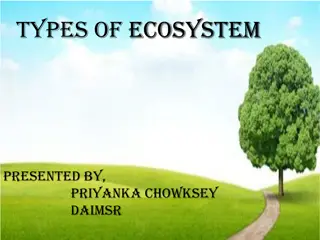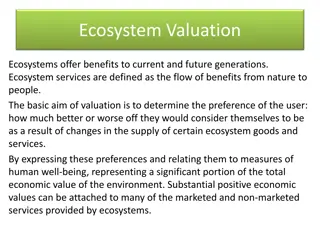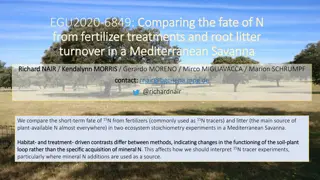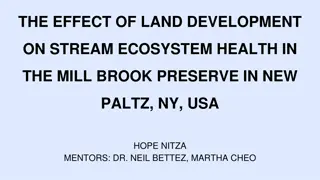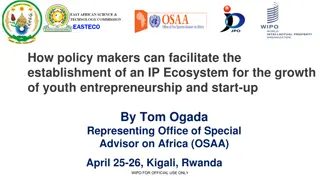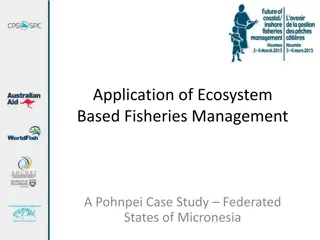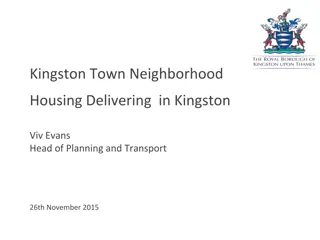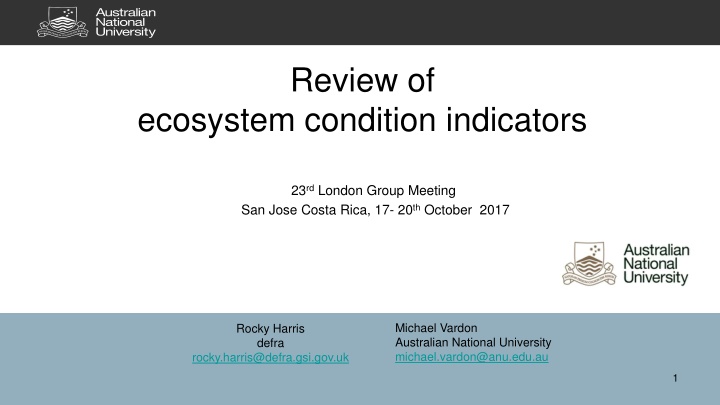
Overview of Ecosystem Condition Indicators and Assessments
Learn about the process of assessing ecosystem condition, including selecting indicators, measuring quantity and quality aspects, and determining characteristics essential for ecosystem health. Explore the connections between ecosystem condition, capacity, and services for a comprehensive understanding of ecosystem well-being.
Download Presentation

Please find below an Image/Link to download the presentation.
The content on the website is provided AS IS for your information and personal use only. It may not be sold, licensed, or shared on other websites without obtaining consent from the author. If you encounter any issues during the download, it is possible that the publisher has removed the file from their server.
You are allowed to download the files provided on this website for personal or commercial use, subject to the condition that they are used lawfully. All files are the property of their respective owners.
The content on the website is provided AS IS for your information and personal use only. It may not be sold, licensed, or shared on other websites without obtaining consent from the author.
E N D
Presentation Transcript
Review of ecosystem condition indicators 23rd London Group Meeting San Jose Costa Rica, 17- 20th October 2017 Michael Vardon Australian National University michael.vardon@anu.edu.au Rocky Harris defra rocky.harris@defra.gsi.gov.uk 1
Ecosystem condition reflects the overall quality of an ecosystem asset in terms of its characteristics The assessment of ecosystem condition involves two distinct stages of measurement regarding both the quantity and the quality aspects of the characteristics of the ecosystem asset. In the first stage, it is necessary to select appropriate characteristics and associated indicators of changes in those characteristics. The selection of characteristics and associated indicators should be carried out on a scientific basis so that there is an assessment of the ongoing functioning, resilience and integrity of the ecosystem asset. Thus, movements of the indicators should be responsive to changes in the functioning and integrity of the ecosystem as a whole. 2
Oslo meeting of the London Group in September 2016 Identified two purposes of ecosystem condition accounts: i) to measure the state of the ecosystem in terms of its capacity to continue to provide services to people and ii) to measure the state of the ecosystem in terms of its ability to function without reference to human use. 3
Latest draft of SEEA EEA Technical Recommendations Three potential indicators for ecosystem condition: 1. A small number of generally applicable ecosystem characteristics across a country could be combined to form an overall condition measure 2. Different characteristics may be developed for different ecosystem types 3. Indicators selected according to their importance in determining the supply of ecosystem services 4
Five review questions 1.Should pressures on ecosystems be included as indicators of condition? 2.How does the concept of ecosystem condition relate to ecosystem capacity and ecosystem capability? 3.How should reference condition be determined? By reference to naturalness, an historical baseline, or a standard prescribed in policies? 4.How should condition metrics properties at larger scales (e.g. fragmentation and ecosystem diversity) be recorded? 5.What indicators should be included in overall indices of condition and how should they be constructed?
Additional factors to consider 1. The area for which condition is being which may be: An homogeneous and continuous ecosystem (e.g. an island covered by forest) or Heterogeneous area of many and/or non-contiguous ecosystems (e.g. an island with several discrete patches of forests, grasslands and wetlands) 2. The method of assessment Ground based Remote sensed 6
17 studies reviewed 8 from Australia 6 from United Kingdom Netherlands South Africa Uganda 7
Conclusions Limited examples of presentation of condition by ecosystem type and ecosystem characteristics proposed in the SEEA-EEA and Technical Recommendations A wide range of different metrics have been used to describe different ecosystem types. Composite indicators have been developed or we already in existence and used 8
Other findings Different approaches are used (e.g. UK a national assessment of different ecosystem types or the Australian assessment all ecosystem types in the Australian Capital Territory) Most focus on terrestrial. One specific to marine (port Phillip Bay Condition of urban areas a gap (measures for air quality in the Australian Capital Territory and Limburg) Measures of condition that emergy at high spatial scales are not well captured 9
Changing extent of ecosystems as a measure of condition at larger scales Either by itself or as one component of composite indictor, ecosystem extent and the location, size and shape of ecosystems have been used a measure of condition 10
Aggregation The spatial data underpinning the accounts in critical and this information has been aggregated in different ways Biophysical boundaries (e.g. water catchments) Political boundaries Different measures of condition have been aggregated into an overall measure of condition. Same measures of condition used across all ecosystems types Different measure of condition use for different ecosystem types 11
Five review questions 1.Should pressures on ecosystems be included as indicators of condition? 2.How does the concept of ecosystem condition relate to ecosystem capacity and ecosystem capability? How should reference condition be determined? By reference to naturalness, an historical baseline, or a standard prescribed in policies? 3.How should condition metrics properties at larger scales (e.g. fragmentation and ecosystem diversity) be recorded? 4.What indicators should be included in overall indices of condition and how should they be constructed?




